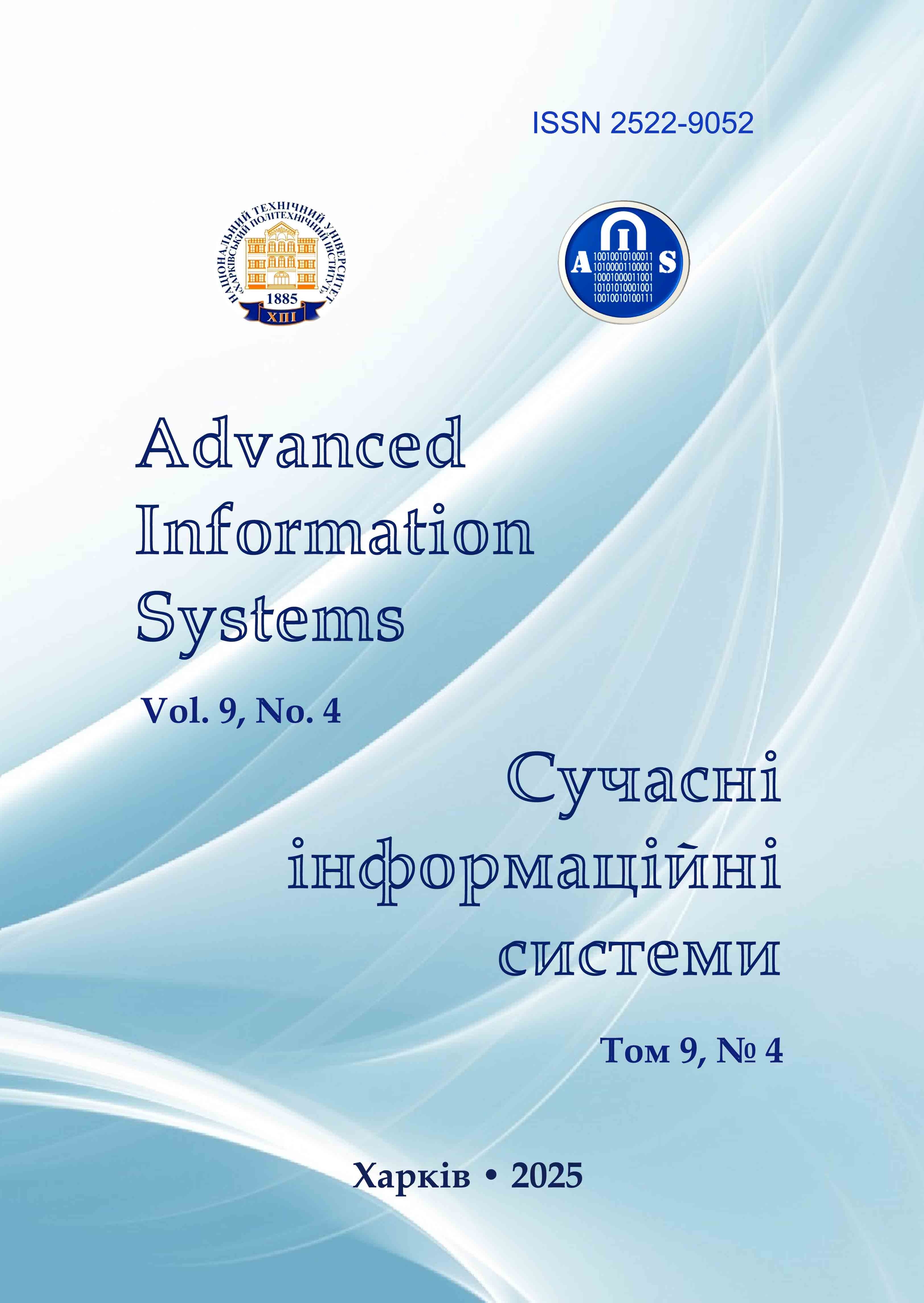ALGORITHMIC DESIGN AND SOFTWARE FOR A MICROCONTROLLER-BASED WEARABLE BIOMEDICAL SENSOR MONITORING SYSTEM VIA ESP-NOW PROTOCOL
Main Article Content
Abstract
This paper presents a hardware-software implementation of a microprocessor-based distributed system for monitoring human motion biomechanics using wireless communication for real-time data transmission. The main objective of the work is to develop an energy-efficient, reliable, and low-cost system capable of autonomously collecting, transmitting, synchronizing, and storing data from inertial sensors in real time. The proposed approach is based on the use of ESP32 microcontrollers, which support direct data exchange via the ESP-NOW protocol. This protocol enables high-speed, low-latency data communication without connection establishment, ensuring fast response and reduced power consumption. A functional system prototype has been developed, consisting of a base station and a set of sensor modules powered by standalone battery sources. The study introduces a specialized algorithm for synchronized data transmission, which includes packetization of inertial measurement unit (IMU) readings and data caching using a circular buffer. This significantly reduces packet loss even under interference and high channel load conditions. The paper describes the loss-handling mechanism, retransmission process, and methods for clock synchronization and maintaining continuous packet numbering in the event of a module or base station restart. A series of tests were conducted in various operating modes, with different numbers of modules, at different distances, and under obstacle-induced interference. Experimental results show that the average packet loss rate when using the proposed algorithm does not exceed 1%, and the probability of severe losses (over 10%) is effectively eliminated. The system has also demonstrated stable performance under real-world conditions and supports scaling up to 20 modules. The obtained results confirm the efficiency and feasibility of using the ESP-NOW protocol in distributed biomedical IoT systems focused on motion monitoring, patient rehabilitation, biomechanical studies, and prosthetic adaptation support.
Article Details
References
(2024), WHO Rehabilitation Need Estimator: All condition categories, Global, All Ages, Both sexes, Prevalent cases Institute for Health Metrics and Evaluation, University of Washington, available at: https://vizhub.healthdata.org/rehabilitation
Tomashevskyi, R., Larin, O., Kolisnyk, K., Zuev, A., Gumeniuk, K., Lurin, I. and Nehoduiko, V. (2023), “Methodology and Use of Experimental Techniques in Analyzing Wound Dynamics of Penetrating Injuries”, 6-th Int. Conference on Nanotechnologies and Biomedical Engineering, ICNBME 2023, pp. 208–217, doi: https://doi.org/10.1007/978-3-031-42782-4_23
Lin, Lu, Jiayao, Zhang, Yi, Xie, Fei, Gao, Song, Xu, Xinghuo, Wu and Zhewei, Ye. (2020), “Wearable Health Devices in Health Care: Narrative Systematic Review”, JMIR Mhealth and Uhealth, vol. 8, iss. 11, doi: https://doi.org/10.2196/18907
Khan, Y., Ostfeld, A.E., Lochner, C.M., Pierre, A. and Arias, A.C. (2016), “Monitoring of vital signs with flexible and wearable medical devices”, Adv. Mater, vol. 28(22), pp. 4373–4395, doi: https://doi.org/10.1002/adma.201504366
Park, Y., Lee, S. and Park, J. (2019), “Recent progress in wireless sensors for wearable electronics. Sensors”, Sensors, vol. 19(20), article number 4353, doi: https://doi.org/10.3390/s19204353
Haghi, M., Thurow, K. and Stoll, R. (2017), “Wearable devices in medical internet of things: scientific research and commercially available devices”, Healthcare Informatics Research, vol. 23(1), pp. 4–15. doi: https://doi.org/10.4258/hir.2017.23.1.4
Guk, K., Han, G., Lim, J., Jeong, K., Kang, T., Lim, E. and Jung J. (2019), “Evolution of wearable devices with real-time disease monitoring for personalized health care”, Nanomaterials, vol. 9(6), doi: https://doi.org/10.3390/nano9060813
Pancevski, B. (2023), “In Ukraine, Amputations Already Evoke Scale of World War I”, The Wall Street Journal, available at: https://www.wsj.com/world/europe/in-ukraine-a-surge-in-amputations-reveals-the-human-cost-of-russias-war-d0bca320
Kuchuk, H., Kalinin, Y., Dotsenko, N., Chumachenko, I. and Pakhomov, Y. (2024), “Decomposition of integrated high-density IoT data flow”, Advanced Information Systems, vol. 8, no. 3, pp. 77–84, doi: https://doi.org/10.20998/2522-9052.2024.3.09
Akhtar, Y., Ali, M., Almaliki, F.A. and Almarzouki, R.A. (2025), “A novel IoT-based approach using fractional fuzzy Hamacher aggregation operators application in revolutionizing healthcare selection”, Scientific Reports, vol. 15(1), article number 2712, doi: https://doi.org/10.1038/s41598-024-83805-6
Kuchuk, H., Mozhaiev, O., Kuchuk, N., Tiulieniev, S., Mozhaiev, M., Gnusov, Y., Tsuranov, M., Bykova, T., Klivets, S., and Kuleshov, A. (2024), “Devising a method for the virtual clustering of the Internet of Things edge environment”, Eastern-European Journal of Enterprise Technologies, vol. 1, no. 9 (127), pp. 60–71, doi: https://doi.org/10.15587/1729-4061.2024.298431
Devipriya, A., Manikandan, N., Sivaranjani, A., Anand, M. and Ragupathi, T. (2025), “The Convergence of Cloud Computing and IoT in Healthcare: A Paradigm Shift Towards Patient-Centric Innovation”, Advancements in Cloud Based Intelligent Informative Engineering, pp. 229–256, doi: https://doi.org/10.4018/979-8-3373-0781-7.ch011
Kuchuk, N., Kashkevich, S., Radchenko, V., Andrusenko, Y. and Kuchuk, H. (2024), “Applying edge computing in the execution IoT operative transactions”, Advanced Information Systems, vol. 8, no. 4, pp. 49–59, doi: https://doi.org/10.20998/2522-9052.2024.4.07
Zuev, A. and Vodka, O. (2022), “Development of a Distributed Wireless Vibration Measurement and Monitoring System”, Proc. 2022 IEEE 3rd KhPI Week on Advanced Technology, KhPIWeek, Kharkiv, Ukraine, pp. 915–920. doi: https://doi.org/10.1109/KhPIWeek57572.2022.9916375
Hoang, T. N., Van, S.-T. and Nguyen, B. D. (2019), “ESP-NOW based decentralized low cost voice communication systems for buildings”, 2019 International Symposium on Electrical and Electronics Engineering, ISEE, Ho Chi Minh City, Vietnam, pp. 108–112, doi: https://doi.org/10.1109/ISEE2.2019.8921062
Eduard, A., Urazayev, D., Sabyrbek, A., Magzym, Y. and Zorbas, D. (2023), “Infrastructure-Less Long-Range Train-Arrival Notification System”, 2023 IEEE Symposium on Computers and Communications, ISCC, Gammarth, Tunisia, pp. 956–962, doi: https://doi.org/10.1109/ISCC58397.2023.10218305
Isnanto, R. R., Windarto, Y. E., Dei Gloriawan, J. I. and Cesara, F. N. (2020), “Design of a Robot to Control Agricultural Soil Conditions using ESP-NOW Protocol”, 2020 Fifth International Conference on Informatics and Computing, ICIC, Gorontalo, Indonesia, pp. 1–6, doi: https://doi.org/10.1109/ICIC50835.2020.9288575
Hiertz, G. R., Denteneer, D., Stibor, L., Zang, Y., Costa, X. P. and Walke, B. (2010), “The IEEE 802.11 universe”, IEEE Communications Magazine, vol. 48, no. 1, pp. 62–70, doi: https://doi.org/10.1109/MCOM.2010.5394032
Magzym, Y., Eduard, A., Urazayev, D., Fafoutis, X. and Zorbas D. (2023), “Synchronized ESP-NOW for Improved Energy Efficiency”, 2023 IEEE International Black Sea Conference on Communications and Networking, BlackSeaCom, Istanbul, Turkiye, pp. 57–62, doi: https://doi.org/10.1109/BlackSeaCom58138.2023.10299761
(2024), Inertial Measurement Unit: BMI160, accelerometer and gyroscope, Bosch Sensortec GmbH, available at: https://www.bosch-sensortec.com/products/motion-sensors/imus/bmi160/
Zuev, A., Karaman, D. and Olshevskiy, A. (2023), “Wireless Sensor Synchronization Method for Monitoring Short-Term Events”, Advanced Information Systems, vol. 7(4), pp. 33–40, doi: https://doi.org/10.20998/2522-9052.2023.4.04
